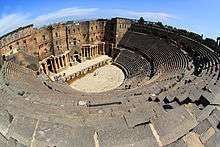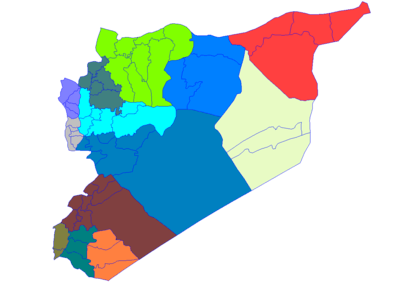Timeline of Homs
The following is a timeline of the history of the city of Homs, Syria.
Prior to 7th century
Part of a series on the |
|---|
| History of Syria |
 |
| Prehistory |
| Bronze Age |
| Antiquity |
| Middle Ages |
| Early modern |
| Modern |
|
| Timeline |
|
|
- 3rd millennium BCE – Citadel of Homs was founded. Biblical scholars have identified the city with Hamath-zobah.[1][2]
- 732 BCE – Syro-Ephraimite War, Assyrians in power.
- 540 BCE – Persian Achaemenid Empire in power (approximate date).
- 64 BCE – The Emesani dynasty were confirmed in their rule as client kings of the Romans.
- 50 AD – Saint Mary Church of the Holy Belt was consecrated.
- 432 AD – Church of Saint Elian was consecrated.
7th–19th centuries
- 636 – Siege of Emesa, city was captured by Rashidun Caliphate.
- 750 – Abbasids wrested control of Homs.
- 855 – Christian population revolted in response to additional taxation under the reign of Caliph al-Mutawakkil.[3]
- 891 – al-Yaqubi noted that Homs was situated along a broad river (Orontes River) which served as a source of drinking water for the inhabitants.[4]
- 944 – Hamdanids took control of the city.
- 1090 – Seljuk Turks occupied Homs under the leadership of Aq Sunqur al-Hajib.[5]
- 1149 – The Mosul-based Zengids under Nur al-Din captured the city.[6]
- 1154 – Al-Idrisi mentioned that Homs was populous, contained open markets, and was frequented by travelers. The residents were pleasant; living with them is easy. The women are beautiful and are celebrated for their fine skin."[7]
- 1164 – Asad ad-Din Shirkuh became Homs' fief, later known as “Emir of Homs”.
- 1175 – Saladin gained control of the city.
- 1225 – Yaqut al-Hamawi mentioned that Homs was large, celebrated and walled, having a strongly fortified castle on its southern hill.[8]
- 1355 – Ibn Batuta visited Homs, writing that it had fine trees and good markets.
- 1400 – Timur seized the city. Nevertheless, he did not sack it as he did in Aleppo, Hama and later Damascus, due to a man called “‘Amr bin al-Rawas” who conciled with him offering precious gifts to save the city.[9]
- 1510 – al-Fadl bin Nu'ayr was sent on an expedition by the governor of Damascus to loot the city markets.[6]
- 1516 – Ottoman Turks in power.
- 1549 – Homs Sanjak was created as part of Ottoman Aleppo Eyalet.
- 1579 – Homs is under Ottoman Tripoli Eyalet.
- 1785 – French traveler, Volney wrote of the city's once great importance and its current "miserable" condition.
- 1832–1840 – city was occupied by Muhammad Ali's Egypt led by Ibrahim Pasha.[10][11]
- 1855 – National Evangelical School was founded by American missionaries.[12]
- 1860s – The city rebelled against Egyptian rule and consequently, the citadel was destroyed when the Egyptians suppressed the revolt. Ottoman rule was soon restored.[6]
- 1864 – Homs became part of Ottoman Syria Vilayet.
- 1870s – Homs' economic importance was boosted again during the depression of the 1870s, as its cotton industry boomed due to a decline European textile production. One British consul referred to Homs as the "Manchester of Syria."[6]
- 1887 – Al Ghassania Orthodox School was established.[13]
20th century
- 1907 – Population: 65,000 (estimate).[2]
- 1908–1913 – Khalid ibn al-Walid Mosque was consecrated.
- 1918 – Homs was captured by the 5th Cavalry Division of the Allied forces in October 1918. Later on, it became part of the French Mandate of Syria.
- 1922 – Homs Museum's ground floor was established, 1st floor finished in 1949, and 2nd floor in 1963.[14]
- 1925 – The city joined Damascus and the southern Druze chieftains in a full-blown revolt against French rule.[15]
- 1928 – Al-Karamah SC was formed.
- 1930s
- 1932 – The French moved their military academy from Damascus to Homs to be established in 1933, later known as Homs Military Academy,[16] and it remained the only military academy in Syria until 1967.[17]
- 1937 – Al-Wathba SC was formed.
- 1959 – An oil refinery was built to process oil for domestic consumption.[6] The city's oil refinery was bombed by the Israeli Air Force (IAF) during the 1973 Yom Kippur War.[18]
- 1960
- Khalid ibn al-Walid Stadium was opened.
- Population: 136,000 (estimate).[19]
- 1973 – Culture House Theater was established.[20]
- 1979 – Al-Baath University was established.
- 1981 – Population: 346,871 (estimate).[21]
- 1994 – Population: 540,133 (estimate).[22]
- 2000 – Bassel al-Assad Stadium with a capacity of 25,000 was inaugurated.[23]
21st century
- 2004 – Population: 652,609 (estimate).[24]
- 6 May 2011 – 9 May 2014 – Siege of Homs, Syrian Army recaptures Homs.
See also
References
- ↑ Dumper, 2007, p. 171.
- 1 2 Cook, 1907, p. 362.
- ↑ Gil, 1997, pp. 296–97.
- ↑ le Strange, 1890, p. 353.
- ↑ Dumper, 2007, p. 172.
- 1 2 3 4 5 Dumper, 2007, p. 173.
- ↑ le Strange, 1890, p. 354.
- ↑ Yaqut al-Hamawi quoted in le Strange, 1890, p. 356.
- ↑ Mohammad Amin Sheikho (2011). حقيقة تيمورلنك العظيم تظهر في القرن الواحد والعشرين- الجزء الثاني (in Arabic). دار نور البشير. p. 43.
- ↑ Collelo, Thomas (1987). "Syria – Ottoman Empire". Syria: A Country Study. GPO for the Library of Congress. Retrieved 28 February 2009.
- ↑ Shaw, 1977, p. 33
- ↑ "Rev. H.H. Jessup Dead" (PDF). The New York Times. 1910-04-29.
- ↑ https://www.zamanalwsl.net/news/46142.html معالم حمص ومشيداتها الأثرية: المدرسة الغسانية.. منارة للعلم
- ↑ "متحف حمص". Directorate-General of Antiquities and Museums (in Arabic). 13 December 2012. Retrieved 3 December 2017.
- ↑ Cleveland, 2000, p. 215.
- ↑ "Military Training". All Refer. Retrieved 3 December 2017.
- ↑ Commins, 2004, p. 130.
- ↑ Seale, 2007, p. 210.
- ↑ Winckler, 1998, p. 72.
- ↑ "افتتاح مسرح دار الثقافة بحمص.. مشوح: نجهد للارتقاء بالفكر الثقافي". Discover-Syria (in Arabic). 27 June 2014. Retrieved 2 November 2017.
- ↑ Population Census Report (1981), Central Bureau of Statistics
- ↑ PUN Demographic Yearkbook (1999)
- ↑ Bassel al-Assad Stadium in Homs
- ↑ General Census of Population and Housing 2004. Syria Central Bureau of Statistics (CBS). Homs Governorate. (in Arabic)
Bibliography
- Dumper, Michael; Stanley, Bruce E.; Abu-Lughod, Janet L. (2007). Cities of the Middle East and North Africa: A Historical Encyclopedia. ABC-CLIO. ISBN 1-57607-919-8. .
- Cook, Thomas (1907). Cook's Handbook for Palestine and Syria. Thos. Cook & Son. .
- Gil, Moshe (1997). A History of Palestine, 634–1099. Cambridge University Press. ISBN 978-0-521-59984-9. .
- le Strange, Guy (1890). Palestine Under the Moslems: A Description of Syria and the Holy Land from A.D. 650 to 1500. Committee of the Palestine Exploration Fund. ISBN 978-0-404-56288-5. .
- Shaw, Ezel Kural (1977). History of the Ottoman Empire and Modern Turkey. Cambridge University Press. ISBN 0-521-29166-6.
- Cleveland, William L. (2000). A History of the Modern Middle East: 2nd Edition. Westview Press. ISBN 978-0-8133-3489-9.
- Commins, David Dean (2004). Historical Dictionary of Syria: 2nd Edition. Scarecrow Press. ISBN 0-8108-4934-8.
- Winckler, Onn (1998). Demographic developments and population policies in Baʻathist Syria. Sussex Academic Press. ISBN 978-1-902210-16-2.
External links
- Khoury Issa Ahmed (1983), "Chapter One, 2300 BCE - 622 AD" (PDF), History of Homs, Al-Sayih Library .
- C. Edmund Bosworth, ed. (2007). "Homs". Historic Cities of the Islamic World. Leiden: Koninklijke Brill. .
| Wikimedia Commons has media related to Homs. |
Coordinates: 34°43′51″N 36°42′34″E / 34.73083°N 36.70944°E
This article is issued from
Wikipedia.
The text is licensed under Creative Commons - Attribution - Sharealike.
Additional terms may apply for the media files.

